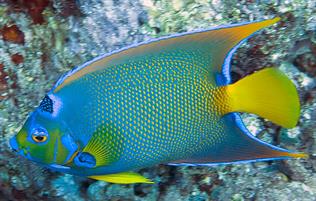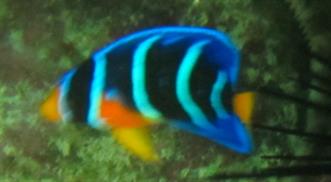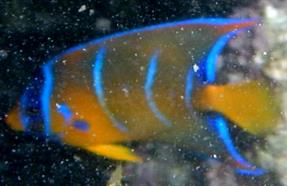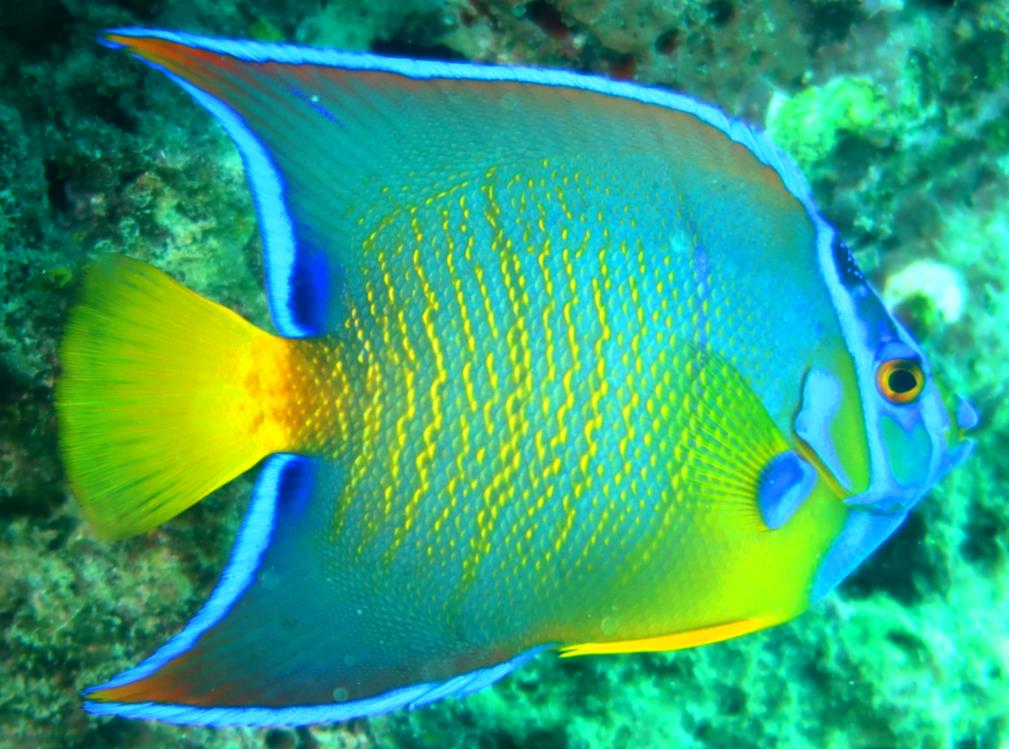




Holacanthus ciliaris
| Ecological Descriptors | ||||
| Habitat | Size (cm) | Diet | Behaviour | Sex |
| Co | 20-35 | Spo (Cor, Veg, Tun, Cl) | i, Pr | F |
Queen Angelfish Adult
Queen Angelfish Adult
.jpg)
Queen Angelfish Juvenile
(C) Brian Gratwicke
Description:
Body laterally flattened with a discoid profile, blue to greenish blue in color with yellow rims on their scales. Ventral and pectoral fins and tail entirely yellow.
Adult: A dark blue spot on the forehead, speckled and ringed with brilliant blue, forming the 'crown'. Lips purplish blue.
Juvenile: Juveniles dark blue with three brilliant blue to white bars, the second bar clearly curved. A dark bar with brilliant blue borders across the eye. Lips yellow, and a yellow area from around the pectoral to the ventral fins. Tail yellow.
Ecology
Found in coral reefs, where they occur solitarily or in pairs, down to 70m (230ft). Adults mainly feed on sponges, supplemented by small amounts of algae, tunicates, hydroids and bryozoans.
Juveniles pick off parasites from the bodies of other fish and are often found amongst finger sponge and coral colonies in order to find protection. These are usually at the bottom of the reefs, out of sight of most of the larger predators.
Life Cycle
Communication between queen angelfish takes place frequently during mating via temporary colour changes in the body of the fish.
Polygynous. During the periods of courtship and pre-spawning, form harems (ratio 1 male: ~4 females). The male flaunts his pectoral fins by thrusting them out repeatedly. The female typically responds by swimming upward through the water. This allows the male to assume his position below the female. He then proceeds to make contact between her cloaca and his snout. As this is taking place, they ascend in unison through the water to a depth of about 18m (60ft), with his belly close to hers. At this depth, the male releases sperm and the female releases eggs into the water column.
Most spawning has been observed to occur during Winter (in Puerto Rico), , although some may take part in spawning more than once annually. Spawning occurs in the evening/ sunset. Females produce between 25,000 and 75,000 eggs during a spawning session.
One fertilised, eggs hatch with a 15-20 hours. The yolk sacs are absorbed by the larvae within 48 hours. After the sacs are absorbed, the larvae begin feeding on plankton. They grow at a rapid rate and can reach a size of 15-20mm as juveniles.
Body laterally flattened with a discoid profile, blue to greenish blue in color with yellow rims on their scales. Ventral and pectoral fins and tail entirely yellow.
Adult: A dark blue spot on the forehead, speckled and ringed with brilliant blue, forming the 'crown'. Lips purplish blue.
Juvenile: Juveniles dark blue with three brilliant blue to white bars, the second bar clearly curved. A dark bar with brilliant blue borders across the eye. Lips yellow, and a yellow area from around the pectoral to the ventral fins. Tail yellow.
Ecology
Found in coral reefs, where they occur solitarily or in pairs, down to 70m (230ft). Adults mainly feed on sponges, supplemented by small amounts of algae, tunicates, hydroids and bryozoans.
Juveniles pick off parasites from the bodies of other fish and are often found amongst finger sponge and coral colonies in order to find protection. These are usually at the bottom of the reefs, out of sight of most of the larger predators.
Life Cycle
Communication between queen angelfish takes place frequently during mating via temporary colour changes in the body of the fish.
Polygynous. During the periods of courtship and pre-spawning, form harems (ratio 1 male: ~4 females). The male flaunts his pectoral fins by thrusting them out repeatedly. The female typically responds by swimming upward through the water. This allows the male to assume his position below the female. He then proceeds to make contact between her cloaca and his snout. As this is taking place, they ascend in unison through the water to a depth of about 18m (60ft), with his belly close to hers. At this depth, the male releases sperm and the female releases eggs into the water column.
Most spawning has been observed to occur during Winter (in Puerto Rico), , although some may take part in spawning more than once annually. Spawning occurs in the evening/ sunset. Females produce between 25,000 and 75,000 eggs during a spawning session.
One fertilised, eggs hatch with a 15-20 hours. The yolk sacs are absorbed by the larvae within 48 hours. After the sacs are absorbed, the larvae begin feeding on plankton. They grow at a rapid rate and can reach a size of 15-20mm as juveniles.

Queen Angelfish Juvenile

151
158


Queen Angelfish Intermediate
423

159







